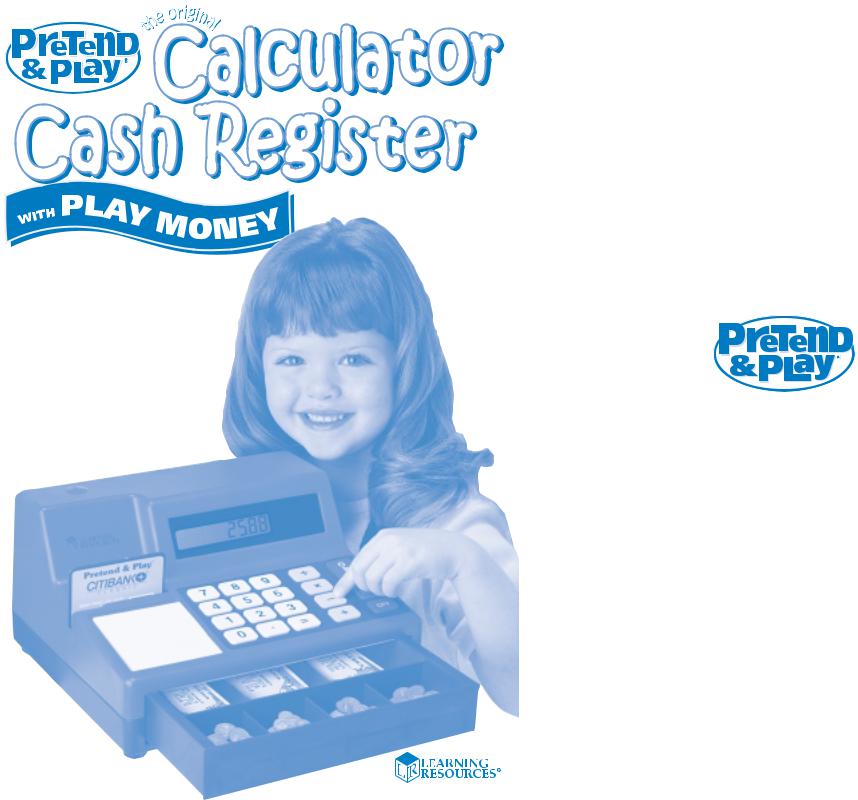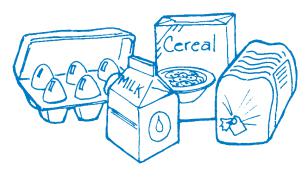Learning Resources LER 2629 User Manual

 Calculator
Calculator
Cash Register
The Pretend and Play® Calculator Cash Register encourages children to learn basic math and calculator skills while it enhances imaginary play. This unique educational toy features a working calculator that will familiarize children, from pre-school age up, with the use of a calculator while they play. The large buttons on the keypad are easy for little hands to press and the cash draw is large enough to hold life-size bill and coins.
Children will naturally learn to add and subtract when they use the Calculator Cash Register for pretend and play, selling products in their ”store”, ringing up purchases and making change.
Calculator Activities
Calculator features:
• Calculator runs on solar power
• Extra large buttons for small hands to manipulate
• An eight digit display
• Error function to show entry mistakes
• Repetitive equal sign for multi-item purchases
• Negative function for teaching integers
• Student entered order of operations for learning skills
Preschool Age Children
Preschool age children will appreciate the realism the working calculator adds to imaginative play. Although preschool age children are not developmentally ready to fully utilize all of the calculator features, playing with the Calculator Cash Register will help them become familiar with the keys and numerals on
the calculator.
LER 2629

Numerals 1 through 9
Enter the number one, and show children the one on the display. Then have children enter the number. Repeat with other numbers. Demonstrate how children can enter numbers larger than nine. As children becomes adept at copying your numbers, they will begin entering numbers of their own. Call out a number for children to enter on the calculator.
Counting Pennies
Count out pennies from the cash drawer. Encourage children to enter the number of pennies you count out. With practice, children will be able to enter the amount of pennies that they have counted themselves.
Beginning Addition
Use the calculator for beginning addition. Use pennies, blocks, or other counters to help children visualize the addition process. Group counters into piles that are less than ten. Count one pile and enter its total into the register. Count the other pile and add it to the first. Show children how the calculator added the two piles together. Push the counter piles together and check the calculator’s addition.
School Age Children
School age children are ready to begin working with the calculator. Use the calculator to augment basic math facts, not replace them.
How Many
Use the multiplication feature of the calculator to determine how many fingers there are in the class-room. Count the children in the room and multiply by ten. Use the same method to calculate how many eyes there are in the classroom.
How Old are We
Use the calculator to add the ages of everyone in the classroom.
Let’s Go Shopping!
You Need:
Calculator Cash Register Money
Empty grocery boxes and containers
Play fruits Play foods Shopping bags Coupons
To Play:
Create a ”supermarket” by arranging products on shelves, the floor, on tables, or even on a row of chairs! Put prices on items for sale. (Keep prices in the single digits for young children. Use double digits and dollars for older children.) Make a shopping list and use coupons. Encourage children to take turns being shoppers or the check-out person. Both jobs are fun!
Use language to reinforce learning as you play: ”Oh, you’ve bought 5 cans of peas!” or ”I’m sorry, you gave me less money than I need. Could I please have a dollar more?” Don’t limit your language to real life, use your imagination! This can be very entertaining (and educational) for all ages. Adult participation adds excitement and richness that can’t be duplicated.
Shoe Store
You Need:
Calculator Cash Register Money
Ruler
Assorted men’s, women’s, children’s and baby’s shoes
To Play:
Help children set up a shoe shop! Jumble shoes into a pile and let the children sort them into pairs and arrange them by size. Place the shoes on the floor or on shelves for viewing. Suggest prices for shoes based on their appearance and type. (Use single digit
